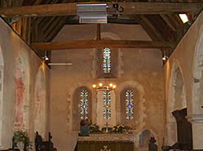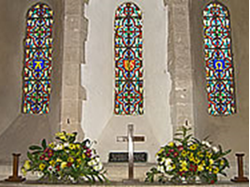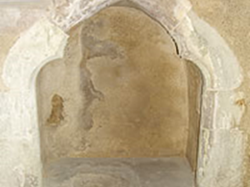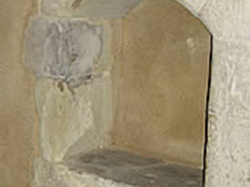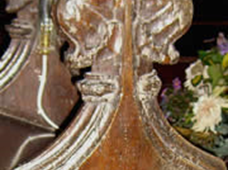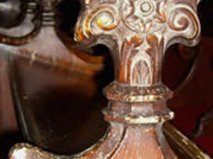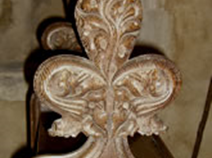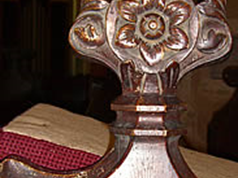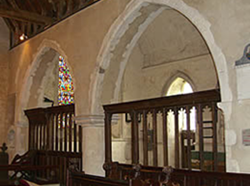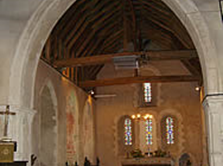Chancel
The chancel is Norman with early English and later medieval alterations. It may never have had an apse at the east end. By the reign of Elizabeth I the chancel was in disrepair due to the Patron, the Archdeacon of Canterbury, not fulfilling his financial obligations including not supplying an annual donation for parish poor. In 1560 the Doddington churchwardens stated that "The chancel is in decay, Mr Archdeacon is Parson there". In 1562 they complained "The chancel lacketh reparation, the fault thereof is in the Archdeacon of Canterbury" .
In 1563 "The chancel is in great decay for lack of shingling, the fault is in Mar Archdeacon of Canterbury". Some work was finally done on the chancel in 1566 but by 1572 the Doddington churchwardens set out the problem in detail clearly at their wits end: " The chancel is very much in decay. The Archdeacon being the parson there, hath and doth withhold 6s.8d. by year, given out of the parsonage towards the reparation of the church eleven years. Also half a quarter of wheat by year, given out of the parsonage to the poor of the parish by the space of six years; which money and wheat hath been used to be paid time out of mind, and the same hath been presented very often;' and they can have no remedy therein"(presentments vol.1571-2 Fol.131). None of the glass in the chancel pre-dates 1572 when the Doddington churchwardens protested again "we present our chancel to be unglazed, so that the minister cannot administer the communion for rain and cold" By 1585 major repairs must have been undertaken for the churchwardens reported only that "Our chancel is faulty, but we will see it amended".
Of the four windows in the east wall one is above three early English lancets, just pointed, but with round-headed rere-arches.
On the north wall one window of a single light is remarkable for its seven-foiled head.
Wall Paintings
The wall paintings in the splays of the lancets in the north wall of the chancel , outlined in red ochre have been dated to the mid-thirteenth century. Of these large, full length figures one has been identified as St francis receiving the stigmata.
Samuel Lewis in his 'Topographical Dictionary of England in 1845 (VollII p.62) noted that when Doddington church "was in course of repair, a full-length portrait of Henry III (1207-1272), in fresco, was discovered in good preservation"
The Low Side Window
The most remarkable architectural feature in Doddington church is the so-called 'low side window' at the west end of the north chancel wall. It is a late medieval example of the fifteenth century. Now glazed it was originally fitted with a shutter only. The hooks for hinges and the bolt hole (filled up some time after 1876) remain in the stonework. To the west of the window, cut in the east face of the recess, is an aumbry, a square cupboard for holding the sacred vessels for the Mass.
Opposite in the east splay, is a small arched image niche above a stone desk with a projection forming a book rest.
No mention has been found for such low windows in English medieval service books, and a variety of explanations have been suggested. Edward Trollope reasoned that a priest within must be ministering to some person, or persons, outside. The window accessories arrangement suggests confession or Holy communion, both under peculiar circumstances. For example if the parishioner was infected with leprosy or the plague. Trollope argued that a practice called 'outer confession' was common, where a person (or persons) could not safely be admitted into the church. The priest could receive confession, pronounce absolution, possibly administered a reserved host via 'the low side window' opening. As an example Trollope referred to the mural painting discovered in Eton College Chapel that represented the converted son of a Jew receiving Holy Communion through such a window.
The Piscina
The piscina (a basin attached to a wall near an altar, where the priest washed his hands and rinsed the chalice) in the eastern wall has only one basin, although there is space for two, while the upper member of its trefoiled head is strangely wide in proportion to its height and to the other members.
Credence
There is also what appears to be a credence (a small shelf, or table near an altar) on the south side of the high altar, instead of on the north as is usual.
Bench ends
Of the chancel woodwork, note the four well-carved medieval poppy-head bench-ends.
Chancel Arcade
It appears that when the south chapel was built (around 1200) the south wall of the chancel was taken down and rebuilt with a pair of arches a little further south, so that it very nearly aligns with the nave arcade. The tie-beams of the chancel seem to be original, but lengthened by scarf-joints so as to cover the increased width. Note the coved heading to the eastern portion of the carved oak screen between the chancel and south chapel. Thought probably to have been the canopy of a seat or sedile. The present sedile is a bench with poppyheads cut vertically to fit against the screen.
Chancel Arch
The chancel arch, opening into the nave, has been described as a beautiful example of thirteenth century stonework, lofty, pointed, and just chamfered, on square imposts with moulded abaci and nook shafts east and west. The shafts have rings, and on the capitals, small upright acanthus leaves turning over here and there, to form crockets. Dr Nikolaus Pevsner compared this work at Doddington with that of Master Mason William of Sens at Canterbury between 1175 and 1178, and the beginings of the Gothic style in England.
While none of the medieval architects, masons, or other craftsmen who worked at Doddington church has yet been identified by Dr John Harvey (English Medieval Architects, Rev.Edn.1987) or others, it seems possible that, since Doddington was an appendage of Canterbury, workmen engaged there may have been sent to Doddington among its other parish churches.
The Double Squint
Pierced through the south pier of the chancel arch is a notable double squint, that gives a view to the altars in both the chancel and south chapel.
Its purpose in medieval times was to enable people in the nave and south aisle to see the Elevation of the Host at Communion, and also to enable a priest standing at an altar between the nave and south aisle to see priests at the two main altars.
